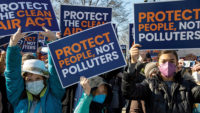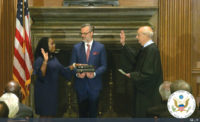The U.S. Supreme Court has limited the ability of the U.S. Environmental Protection Agency to regulate power plant greenhouse gas emissions, but the ruling was more limited than some environmental advocates had feared.
The key question in West Va. v. EPA—a decision released on June 30, the final day of the court’s current session—was whether EPA during the Obama administration exceeded its authority in reinterpreting statutory language within the federal Clean Air Act, specifically Section 111(d), to set emission reduction goals beyond individual power plants but for entire systems in its 2015 Clean Power Plan. In rereading that provision of the statute, EPA said that it had authority to help facilitate the U.S. energy transition from coal-fired power to cleaner natural gas and renewables.
In its 6-3 decision, the nation’s top court now has ruled that EPA overstepped its authority.
But the decision did not raise the specter of Chevron U.S.A. v. Natural Resources Defence Council, a 1984 Supreme Court decisipn that gave federal agencies broad discretion by courts to interpret the meaning and congressional intent of laws relating to their scope of responsibilities. Environmental advocates had feared that a reversal of Chevron could have severely curtailed agencies’ ability to promulgate any regulations.
Michael Haggarty, associate managing director of Moody’s Investors Service, said in a statement that the decision will have “little impact on the credit quality or carbon transition related capital expenditure plans of U.S. regulated utilities, which are being driven more by customer and investor preferences, the declining cost of renewable energy and individual state energy policies.”
But he said it will likely “reduce the risk of an accelerated carbon transition timeline driven by federal policy that could adversely affect utility credit, as it is unlikely the U.S. Congress will act as quickly or deliberately as EPA would have.”
The Opinion
Writing for the court, Chief Justice John Roberts said: “Capping carbon dioxide emissions at a level that will force a nationwide transition away from the use of coal to generate electricity may be a [sensible solution]. But it is not plausible that Congress gave EPA the authority to adopt on its own such a regulatory scheme in Section 111(d). A decision of such magnitude and consequence rests with Congress itself, or an agency acting pursuant to a clear delegation from [it].”
Roberts cited the major questions doctrine, which applies when an agency asserts rules or powers that are highly consequential and which are likely beyond the scope of what Congress intended.
“This is a major questions case,” Roberts wrote. For four decades, he said, EPA has traditionally viewed Section 111(d) in relation to individual stationary sources, not entire systems. EPA's re-interpretation asserts that “Congress implicitly tasked [the agency] and it alone, with balancing the many vital considerations of national policy … There is little reason to think Congress assigned such decisions to the agency.”
In their dissent, Justice Elena Kagan, joined by Justices Stephen Breyer and Sonia Sotomayor, wrote: “Today, the Court strips the Environmental Protection Agency of the power Congress gave it to respond to ‘the most pressing environmental challenge of our time,” as stated in the landmark Massachusetts v. EPA, which gave EPA the authority to regulate greenhouse gasses.
Brian Turmail, executive vice president of public affairs for the Associated General Contractors of America, said in an email to ENR that it is reviewing the ruling to gauge how it might impact members.
“The challenge is that the ruling does not appear to prohibit EPA from taking future actions, it just identified administrative problems with how [the agency has] been going about it so far," he said. "Considering that EPA is still crafting a regulation to set limits on greenhouse gas emissions from power plants, the real question is what impact the ruling will have on the agency’s pending rule.”
What’s Next?
The Obama-era Clean Power Plan never actually went into effect, as several states filed lawsuits challenging it beforehand, and the then-incoming Trump administration repealed and replaced the rule with one that did not rely on EPA’s novel interpretation, at the time, of Section 111(d).
EPA's planned new regulation will provide more protections than the Trump rule, but the agency hopes it will still be legally defensible. The Chesapeake Bay Foundation notes that while the decision narrows the federal government’s authority under the federal Clean Air law, “it leaves room for EPA to act on its duty to tackle carbon emissions from power plants.”
In a statement, EPA Administrator Michael Regan said that while he is “deeply disappointed” in the ruling, the agency is “committed to using the full scope of [its] authorities to protect communities and reduce the pollution that is driving climate change. We will move forward to provide certainty and transparency for the energy sector, which will support industry’s ongoing efforts to grow our clean energy economy.”
Justice Stephen Breyer formally stepped down at the end of the session, as he had announced previously, after serving for 27 years on the court. He swore in the court’s newest justice, Ketanji Brown-Jackson.





